
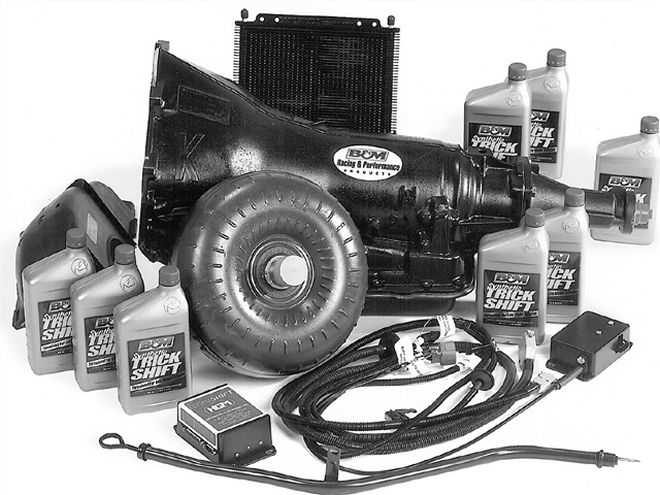 The decision on which transmission to put in your car rests on many factors. When you make your choice, make sure to buy all the parts necessary to complete the installation. B&M Racing makes it easy by including everything you will need in one package.
The decision on which transmission to put in your car rests on many factors. When you make your choice, make sure to buy all the parts necessary to complete the installation. B&M Racing makes it easy by including everything you will need in one package.
To shift or not to shift? That is the question. Wither 'tis nobler in the minds of enthusiasts to use a third pedal or not is a matter for debate. Apologies to William Shakespeare, but to car enthusiasts, can any question be more important than choosing the right transmission for your car?
When it comes to installing the right transmission, the decision to use either a manual or an automatic trans depends on your intended use for that vehicle. If you are a purist and drive a hot Cobra, then a four-speed manual transmission is a tradition. If you cruise to the local car show in a '32 coupe, then a five-speed automatic might be your choice. There are no rules as to what the correct application is. We know of one Cobra manufacturer who installed an automatic in his wife's car because she was tired of shifting.
Some would argue that when the driver can shift the transmission, he has more feel for the car. When the transmission is in the proper gear to match the torque range of the engine, acceleration is instantaneous and controlled. By downshifting, the driver can also use the compression of the engine to help slow down the car.
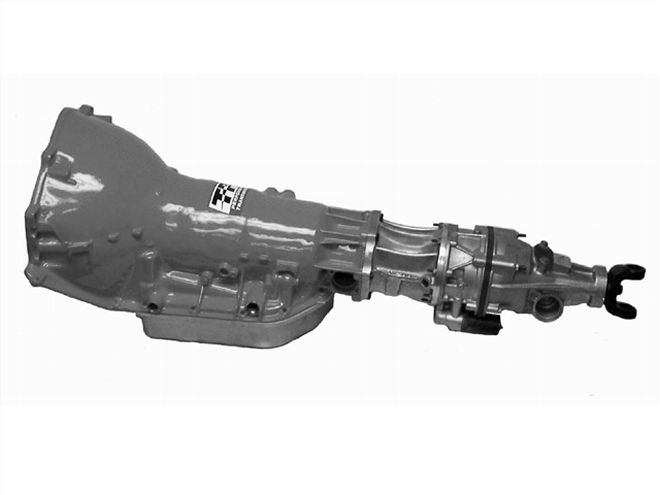 TPI Performance builds automatics, which are just the ticket for dragstrip and heavy street traffic use. If shifting is your thing, you can still shift with an automatic transition that employs a full, manual valve body.
TPI Performance builds automatics, which are just the ticket for dragstrip and heavy street traffic use. If shifting is your thing, you can still shift with an automatic transition that employs a full, manual valve body.
Dave Smith of Factory Five Racing said there are numerous reasons to install a standard transmission in your kit car: "A Cobra replica with a manual transmission has a better resale value because that is how the original car was configured. Therefore, typically, buyers looking for a Cobra replica will look for a stick shift, but if you are going to do hard-core drag racing, you cannot beat an automatic transmission. For road racing and autocrossing, I believe you need to have a manual transmission. For driving on the street, it is personal preference. I prefer the manual trans because it is more period-correct. An automatic in your daily driver may be more convenient, but banging a four-speed is a lot more fun for me."
Steve Lancaster at California Performance Transmission advocates automatics. He told us, "The advantages of a properly built automatic transmission in a kit car application are numerous. Dragstrip results speak for themselves; unless it's a clutchless manual transmission, nothing will be as consistent or as strong as a properly built automatic and complementing torque converter.
While the open road course is a different environment than that of the dragstrip, a properly built automatic will boast better times than those of an identically outfitted manual vehicle in all but the most competitive vehicle.
On the street, auto gearboxes greatly increase the driveability and "fun-factor" for the kit car enthusiast. No more traffic jams spent with the clutch halfway engaged (and the accompanying spaghetti-noodle leg).
Jon McKean, director of operations for TPI Performance, builders of automatic transmissions, likes automatics for rear-wheel-drive cars and for cars that take on the dragstrip for "quarter-mile consistency." He said, "For street use, it is an issue of labor for the driver--the way traffic has increased. Heat is also a factor that is improved with an automatic, and wear and tear on the engine and clutch is lessened. An automatic allows you to do what you want to do EVERY TIME. You rev the engine to 2,500 rpm to move gears without missing a shift."
McKean is sympathetic to shift-heads, too. He said, "If shifting is your thing, you can still shift with an auto tranny. We can build one for you that shifts; you just don't have to activate the clutch pedal. That will put you in full control, and you can shift when and where you want to shift--it is called 'a full, manual valve body.'"
McKean told us that high-performance only for manual shifts is a thing of the past. He said, "Higher horsepower works with an automatic. If you have 600-700 hp, you can still run an automatic with overdrive. We package a Turbo 400 for Chevy trannies, a Ford C6, and a 727 Chrysler, mated with bolt-on overdrives that will take 1,000-plus hp."
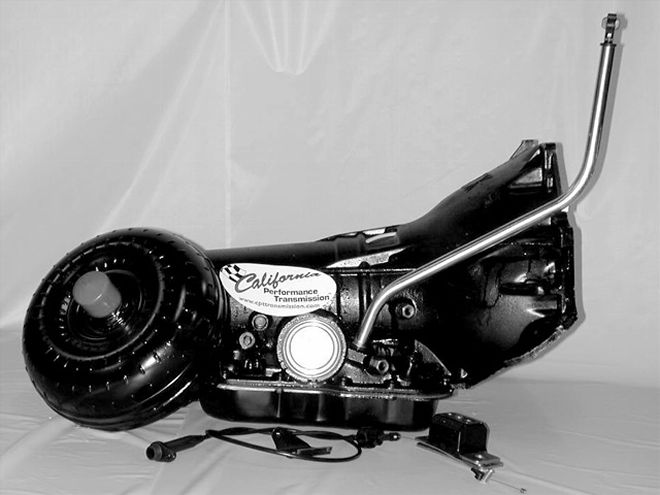 A pioneer in automatic transmissions, California Performance Transmission is a leader in overdrive four-speed transmission swaps. A properly built automatic complements a torque converter perfectly.
A pioneer in automatic transmissions, California Performance Transmission is a leader in overdrive four-speed transmission swaps. A properly built automatic complements a torque converter perfectly.
Keisler Automotive Engineering is a leader in application-specific, modern-technology five- and six-speed manual transmissions and systems. Its founder, Shafi Keisler, believes manual is the way to go. He said, "We sell lots of transmissions to kit car builders who understand that you put 15 to 20 percent more power to the ground in a manual than in an automatic, as there is very little parasitic loss in a manual trans system. Heat is parasitic loss, plus you link power to the ground instantly in mechanical coupling (manual) as opposed to hydraulic coupling (automatic). Another key point is that our trans is 99 pounds lighter than an automatic, and some automatic systems weigh as much as 200 pounds more. When you are dealing with a 2,250-pound kit car, that weight is significant."
He added, "With manual, you get more flex in gearing, deeper First gear (if you like it), and taller overdrive. Our overdrives range from .8 to .5. That is a 20 to 50 percent reduction in rpm. Typical for automatics with overdrive is 16 percent. With modern hydraulic systems, it is very easy to couple the floor pedal to clutch fingers, so gone are the days when you had to fabricate complex mechanics. Your car will run cooler (with a manual) so there's no need for a tranny oil cooler. And with shifter position flexibility, we have 15 shifter positions available to suit any car requirement."
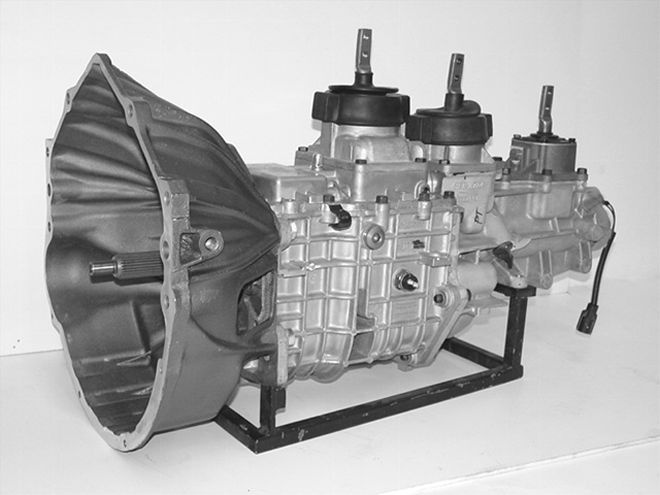 Keisler Automotive Engineering puts out five-speed and six-speed transmission systems with multiple shifter locations. Multiple shifter locations can supply an appropriate system for any kit car or engine.
Keisler Automotive Engineering puts out five-speed and six-speed transmission systems with multiple shifter locations. Multiple shifter locations can supply an appropriate system for any kit car or engine.
Other Considerations
The amount of horsepower and torque under the hood is another consideration. Knowing the differential gear ratio and the height of the rear tires on the car also comes into play when choosing the right transmission. The transmission and rearend ratios work together to calculate the final drive ratio. The size of the tire affects the overall speed of the vehicle. All of this is important in determining the rpm the engine turns when cruising down the road in high gear.
There are many transmission choices on the market. We contacted some of the industry leaders to get their viewpoint on which transmission is best for different applications. Mike Cardella at National Drivetrain informed us tha "Mustang-based cars will use the T5 or the Tremec transmission. Many of our customers are going with the Tremec 3550 or 3550 TKO because they are lighter than the T5 and more durable. The 3550 is the base model, while the stronger version is the 3550 TKO. The Tremec's gears are stronger than T5. With the Tremec, they are not burning up the inputs or the clusters. Our GM customers prefer the Muncie M21 or M22 or the Richmond T10.
"The Tremec is a five-speed. The Borg-Warner T56 and Richmond are six-speeds. The splits on a six-speed are very close. That is an advantage for the guy who wants to do a little street racing. With the Richmond, you can pick your own ratios because the transmission is custom-built."
Cardella added, "The engine's torque, along with the customer's preference, will determine if he buys a four-speed with overdrive or a five-speed with overdrive. Some people don't like to shift into Fifth gear, others do. For street use, you want something with an overdrive for cruising."
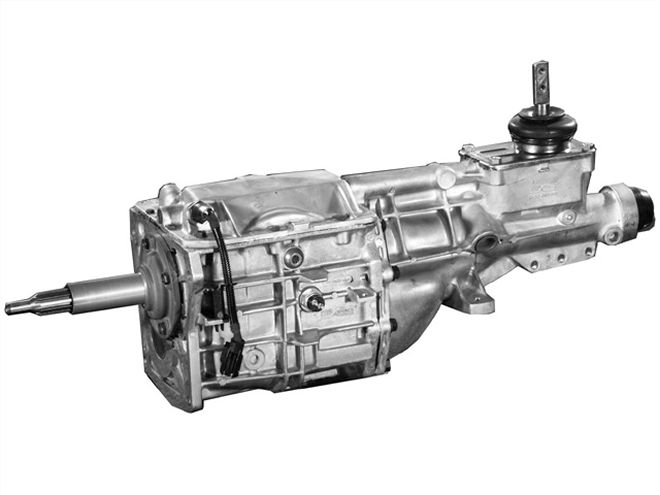 The Borg-Warner T5 is strong enough to handle a lightweight car with a 302 motor putting out 250 horses and producing 295 lb-ft of torque.
The Borg-Warner T5 is strong enough to handle a lightweight car with a 302 motor putting out 250 horses and producing 295 lb-ft of torque.
Factory Five's Dave Smith considered transmission selection and told us, "In our cars, we use the Tremec TKO and the T5. We like to stick to the Borg-Warner T5 in the stock cars. For the heavier-duty big-block cars, we go with the Tremec.
"A transmission in a 2,000-pound car handles torque a lot differently than in a 3,000- or 4,000-pound car. It also depends on the tires you are running. If the tires spin freely, it is going to put less stress on the transmission. In most 2,000-pound applications, the T5 is going to be fantastic. The T5 is strong enough to handle a car with a 302ci motor putting out 250 horses and producing 295 lb-ft of torque, because the clutch is going to slip at 300 lb-ft of torque, which is no problem for the transmission."
Because most kit cars and street rods are so light, the tires are going to break loose long before you stress the transmission. There is a limit of adhesion to any tire. Once that point is surpassed, it does not make any difference how much more horsepower you apply; the tires are just going to go up in smoke.
Jasper Performance Products' Cecil Ragsdale added, "The strength of the Richmond transmissions, more than anything else, is why we are selling Richmond products. They are rated at 450 lb-ft of torque out of the box. The five- and six-speeds can handle that and more. We try to stick with one or two standard ratios. Once you start switching the ratios around, it gets expensive pretty quickly.
"With the five-speed, you change the differential ratio around. If you have 3.00 gears on the rear, you have an equivalent to 4.56 gears through the first four gears. The fifth would be about one-to-one, which would be a 3.00 gear. "In our Cobra, we found the 3.27 was the ideal gear for our 351 Windsor making 450 hp. With the five-speeds, you have the real deep gears through the first four gears and Fifth is almost like driving an overdrive."
Many racers believe they need a manual transmission, if they road race or autocross their car. Road racers downshift before entering the turn. They use the engine's compression to help in braking the car. When the driver gets back on the power, with a manual transmission, he is in the correct torque range and will have instant acceleration. On a tight slalom course, an argument can be made for using an automatic tranny. You put it in one gear and just concentrate on not hitting any cones.
California Performance Transmissions' Lancaster disagrees. He said, "Downshift and upshift timing are non-issues, allowing the driver to concentrate on proper vehicle placement when entering and exiting turns, which can be accomplished without lifting from the throttle in most instances. A properly designed torque converter, such as one of our Heavy-Duty Mega-Torque units, will also provide additional torque multiplication that is not available with manual transmissions. And California Performance Transmission has pioneered overdrive four-speed transmission swaps and can provide units behind virtually any engine/chassis combination."
But Keisler told us, "We have seen a significant number of swaps the other way, from automatic overdrive to manual overdrive transmissions. In addition to the benefits in weight and heat reduction, many drivers just believe, as we do, that a stick is just more fun to drive."
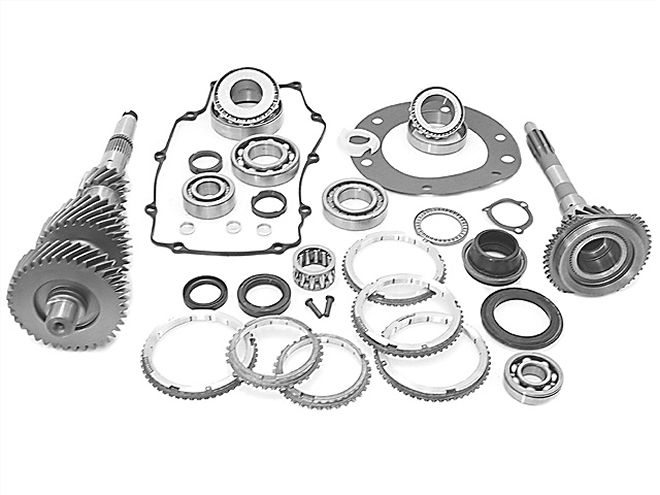 National Drivetrain offers high-quality, rebuilt "Platinum Torque" manual transmissions that are backed by a standard 12-month unlimited-mileage warranty.
National Drivetrain offers high-quality, rebuilt "Platinum Torque" manual transmissions that are backed by a standard 12-month unlimited-mileage warranty.
Quarter-milers tend to voice that if the car is going to be raced at the drags, the automatic transmission is the way to go. You stomp your foot on the accelerator and hold it there as the trans does all the work for you. If you want to downshift, you need a manual transmission. If you want to go up through the gear as fast as quickly as possible, you want an automatic. A manual transmission will have better deceleration, while an automatic has better acceleration.
There is no denying that an automatic is more convenient to drive, especially in heavy stop-and-go traffic. It also takes less room to shift compared to a four-speed transmission, and there is one less pedal in the foot box area. If your kit car is cramped, the automatic gives you more room.
However, most often, automatic vs. manual selection is a matter of choice, perceived fun, tradition, convenience, skill level, and comfort.
Recommendations
An automatic handles torque a lot better, therefore, there are fewer stresses on the engine, driveshaft, motor mounts, third member, and rear axles. In addition, the clutches last a lot longer in an automatic than in a manual transmission. Having said that, you still must choose the right transmission to match your engine. If you are using a small-block Ford with a lot of horsepower, bolt on a C4 transmission. If you are running a big-block, a C6 is the way to go. If you are traveling on the freeway, cruising at higher speeds, and do not have a real strong engine, the Ford AOD is the answer. It is the only transmission with overdrive capabilities. The C4 and C6 are three-speed transmissions. The disadvantage to not having an overdrive is that the cruising speed will be at a higher engine rpm. Instead of running down the highway at 2,100 rpm, it may take 2,800 rpm to maintain the same speed without an overdrive transmission. The C4 is a strong transmission that will handle up to 500 hp. Anything higher will be handled better by the C6. The AOD will not take much more than 400 horses.
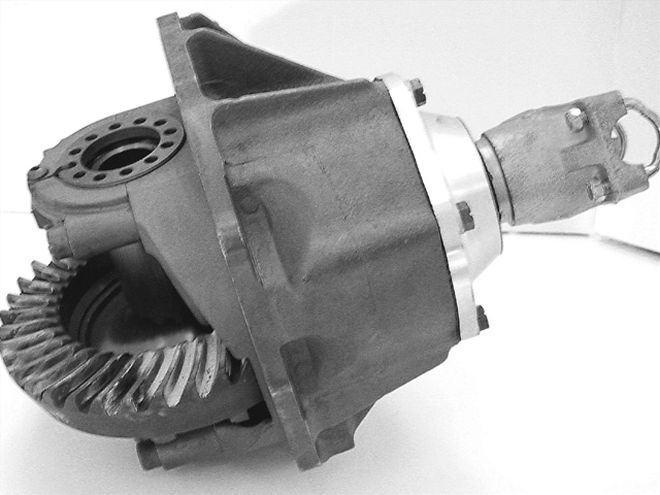 Matching the rearend gears with the transmission gearing is important for off-the-line acceleration and setting highway cruising speeds.
Matching the rearend gears with the transmission gearing is important for off-the-line acceleration and setting highway cruising speeds.
Cars with Chevrolet motors have two choices of transmissions. A relatively light car with moderate horsepower can use the Turbo 350. It works well in cars under 3,500 pounds and with less than 500 hp. When you get above those levels, the Turbo 400 is your transmission. For the street racer, the Turbo 400 will stand up to the abuse better.
A rebuilt automatic transmission is a good buy because it is less expensive, and a number of companies have produced bullet-proof rebuilt units for years. Companies such as TCI, TPI, California Performance Transmissions, and B&M have transmissions on the shelf, ready to ship. If you have a special need, purchasing a transmission from a custom rebuilder, such as A-1 Transmissions, may be a good idea.
We asked Bob Ritzman at B&M what they do when they rebuild a transmission. He answered, "We start out with a solid core. We disassemble and clean it. The inspection process then takes place. We go through all the components, replacing the questionable pieces. We put in all new friction materials, bushings, gaskets, and seals. We recalibrate the valve bodies for better shifting performance. Our technicians reassemble the transmission and test it on our transmission dyno. Once we are finished, we know it is a fully functional transmission that meets our pressure requirements."
B&M also offers rebuild kits for those owners who already have an automatic but want to upgrade it. We asked Ritzman how difficult is it to rebuild a transmission. He said, "The average person can completely rebuild the trans themselves using one of our kits. There are lots of things that wear out. The expendable parts are in the kit. It is a lot of work. They have to do a lot of cleaning themselves. It is a full day's job after everything is cleaned up. This is provided you have a good core transmission to start with. We assume all the internal hard-parts are not damaged and are serviceable. If they are not, that gets into some extra money."
Custom Transmissions
If you do not want the hassle of rebuilding the transmission yourself or want a different gear ratio than what comes stock in most rebuilt transmissions, then find a custom rebuilder such as A-1 Transmissions. A-1's Marvin Ripes explained the benefits of changing gear ratios. He said, "We can change First and Second gear on the Turbo 400 and First gear in the 350. This allows the guy to run a higher gear for the highway and still have enough Low gear for acceleration. There are more gear ratios available for the 400 than the 350, but there is no overdrive.
"In the 400, we have a gear set that is 3.00 vs. a 2.48. That is a 21 percent reduction. If you had a 3.00 rearend with a 21 percent reduction in First gear, you end up with a 3.63 equivalent. That gives you a good highway cruising ratio. You can have your cake and eat it too. Another option is a 3.25 ratio. With the 21 percent reduction, that gives you a 3.93 ratio. You still have the acceleration of a 3.90 type of gear and the highway cruising of the 3.25."
So, which transmission is in your future? Automatic or manual? Both make sense depending on your usage. Both make the driving experience enjoyable. As William Shakespeare might say, "To thine own self be true." And if he were Mario Shakespeare, he might have said, "To thine own CAR be true." KC